Specialized 'GPCR' proteins are the key to protecting the fly brain
In the brain, it’s usually neurons that get all the attention. But there’s another type of brain cell that’s just as critical to our ability to think, walk and process information. It’s the glial cell, and without it, neurons wouldn’t last long.
 (opens in new window)
(opens in new window)
In the fly, specialized glial cells (green) join together to form a protective sheath around the nervous system. A new GPCR protein (magenta), identified by Rockefeller scientists, controls the shape of the glia and is an essential regulator of the blood-brain barrier.
In a new report published in the October 7 issue of Cell, researchers led by Rockefeller’s Ulrike Gaul, who studies nervous system development in fruit flies, show that a protein from a class of molecules called G-protein coupled receptors (GPCRs) is essential for certain glial cells to do their job.
Glial cells form the support system that keeps neurons fed and healthy. They envelope and protect neurons, guide the development of connections between them, supply them with the nutrients they need, and clear away the old and dying when they’re in the way. In flies, glia also form the blood-brain and blood-nerve barriers, which restrict what molecules and substances gain access to the nervous system.
But because the neuronal structures they surround are complex, in order to do their jobs glial cells must be extraordinarily flexible, able to twist, flatten and stretch themselves into extreme shapes.
That’s where GPCRs come in. GPCRs form a large class of proteins that transmit signals through the cell membrane and are essential in many different processes, but until now, nobody knew what role, if any, they played in glia. Gaul, who is the head of Rockefeller’s Laboratory of Development Neurogenetics, conducted a large-scale screen that used microarrays to detect genes that are differentially expressed in glia, and identified a new GPCR and several molecules involved in transmitting the GPCR signal.
Closer inspection revealed that the GPCR signaling components are specifically expressed in the surface glia that ensheath the nerve cord and establish the blood-brain barrier. Gaul therefore suspected that they might be related to the glia’s ability to form an insulating barrier. Before this idea could be tested, however, several obstacles had to be overcome.
“Scientists who study flies have not worked much with this type of cell for a number of reasons,” says Gaul. “Most importantly, the blood-brain barrier forms very late in development, which makes it difficult to use many traditional methods, like antibody staining, to study cell development and function.”
To solve this problem, Tina Schwabe, a visiting student in the Gaul laboratory and the first author of the study, used fluorescent proteins that glow in response to certain wavelengths of light and permit scientists to track protein distribution in live animals as they develop. Schwabe also devised a technique that allowed her to probe the integrity of the blood-brain barrier. By injecting dye into the fly’s body cavity, and then observing whether the dye penetrates into the nerve cord, she could measure whether or not the glial cells prevent substances from crossing into the nervous system.
Using mutant flies in which individual components of the GPCR signaling pathway are either missing or overactive, Schwabe and her colleagues then set out to systematically study their role in the formation of the blood-brain barrier.
They found that in the mutant flies the injected dye penetrated deeply into the nerve cord. But they also observed problems at the cellular level. “In a normal fly, the surface glia form a nicely organized, tiled array, where all the cells are roughly the same size,” says Schwabe. “In the mutants, the first difference you see is that the cells are misshapen and disorganized.”
Closer examination revealed further differences. Septate junctions, which connect neighboring glial cells and are essential for proper insulation, are normally visible all along the circumference the glia. In the mutant flies, the junctions are unevenly distributed along the outside of the cells and in some places missing altogether. Similar misdistribution was observed for the actin cytoskeleton, an internal framework that maintains cell shape and enables cell movement. Put simply, the mutant cells aren’t able to stretch or twist into the shapes they need to do their jobs.
“We think that the diminished septate junctions are secondary to the compromised actin cytoskeleton,” Gaul says. “The GPCR pathway regulates the cell morphology, and the actin cytoskeleton is important for extensive interdigitations between the glial cells. With the actin compromised, the interdigitations don’t form properly, leading to problems with septate junction formation.”
The genes Gaul, Schwabe, and colleagues identified in fruit flies are also found in vertebrate animals, including humans. In vertebrates, Schwann cells wrap themselves around neurons and also form septate junctions. “In flies, all ensheathing glia, all the cells that envelop neurons and form septate junctions, appear to have this pathway,” says Gaul. “These genes are essential for orchestrating cell shape, and it will be interesting to see what roles the proteins play in other cell types and in vertebrates.”
Cell 123(1):133-144 (2005)(opens in new window)


